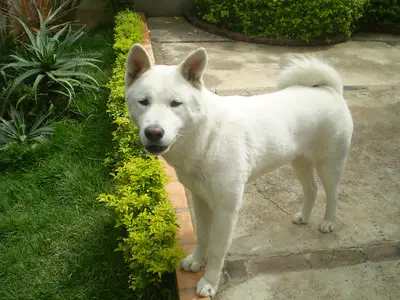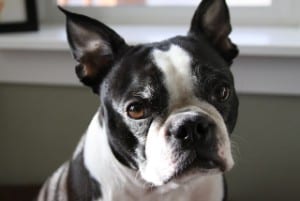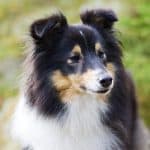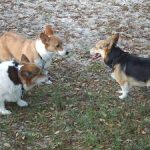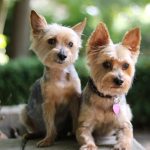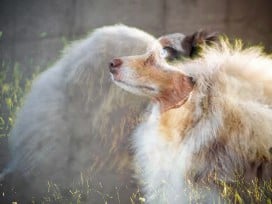
What do you get if you cross a Red Heeler with a Great Pyrenees dog?
Although this sounds like the start of a bad joke, this mix of these two popular breeds does exist.
And if you are looking for a punchline for the joke, the answer is that you will get a shepherd and a bodyguard rolled into one.
How about that for some personality traits?!
But because we are talking about a mix between two distinct breeds of dogs, it is difficult to know the exact balance of traits you will get.
After all, any type of breeding is a bit like a lottery!
But to give you more of a clue let me give you some headlines…
Highlights
- The Red Heeler Great Pyrenees is a new hybrid that is bred by crossing two working dog breeds: the Australian Cattle Red Heeler dog and Great Pyrenees.
- They’re a relatively new breed, so much so that they don’t have an official name yet. Therefore, we will call them by simply putting the two parent breeds’ names together. They also haven’t been officially recognized by kennel clubs.
- They are a large breed and are very active. They will need a lot of exercise .
- They’re also intelligent and responds well to training.
- They are very loyal by nature. With good training and early socialization, they can be good with family and kids.
- They are very good as farm or house guard dogs.
Breed History
The Red Heeler Great Pyrenees is a relatively new dog breed. It’s not formally recognized by kennel clubs, so their traits and features aren’t defined. To better understand this breed, we can look into their parent breeds’ characteristics.
The Parents
Red Heeler (Australian Cattle Dog)
Red Heeler is a nickname for Australian Cattle Dog breed with red coat, distinguishing them from their Blue Heeler counterpart. Australian Cattle Dogs are known for being one of the best herding breeds. In the 19th century, they were purposefully bred in Australia to herd cattle. Because of this daunting task, the Australian Cattle breed have developed many hard-working qualities such as tenacity, stamina, intelligence, and even decision-making skills.
Even though they are working dogs, Red Heelers still make really good pets. They create a bond with their owners and instinctively protect them. The only problem you might face with their temperament is their overly active nature. It’s in their blood to herd and chase around livestock, so if you keep them as a house pet you need to give them a lot of stimulation and exercise. Otherwise, they tend to become destructive as a way to release pent up energy and stress.
Some people think Red Heelers are more aggressive than Blue Heelers, but this isn’t true. Red Heeler and Blue Heeler are the exact same breed (Australian Cattle Dog) with different colouring, just as their names suggest. Red Heeler has very distinct red speckled coat. They’re named Heelers because of their tendency to nip at cattle’s feet if they don’t move as herded.
Red Heelers are medium sized canines. A male Australian Cattle grows up to 20 inches while the females grow up to 19 inches. Their average weight is around 15-22 kg (33-49 lb). They have double coat: a white upper coat and thick red undercoat that shows through the white coat, giving them their signature reddish look.
Great Pyrenees
If Red Heeler is a livestock herd, Great Pyrenees is a livestock guard. They were bred in the mountains of France with the purpose of protecting livestock animals from predators. Because of this, they are nocturnal by nature, as they usually guarded livestock at night-time when the shepherds were sleeping.
They’re very well-mannered and are great, devoted, family dogs. Great Pyrenees are very affectionate with family and can be good with kids. Their nature as a guard dog makes them territorial and protective, so they will be suspicious of strangers and need to be trained not to bark too much. Although not as much as Red Heelers, they are active dogs that need regular stimulation and play time so that they don’t become destructive.
Appearance-wise, they are fluffy, white-coated, big dogs. They grow up to 32 inches of height and weigh up to 115 pounds. Their serious, imposing, stature makes them often be referred to as “majestic”.
Size and Life Expectancy
Even though Red Heeler is a medium sized breed, usually a mix of Red Heeler and Great Pyrenees will result in a big dog, weighing up to 60-100 pounds. It might be smaller than the average Pyrenees but still big enough to be considered a big canine. Their average life span is 10 to 16 years, depending on which gene is more dominant because Great Pyrenees tend to live longer than Red Heelers.
Appearance
A Red Heeler-Great Pyrenees has floppy ears like their Great Pyrenees parent, instead of taking after Red Heeler’s standing ears. They will also take after Great Pyrenees’ big stature. The mixture of Red Heeler’s short hair and Great Pyrenees’ fluffy long coat results in a medium coated pup.
Their coat colour is a combination of both parent breeds, ending up in a beautiful blending of Great Pyrenees’ snow white and Reed Heeler’s distinct red streaks. Depending on the percentage of the genes, the amount of red streak varies but they are definitely whiter than a purebred Red Heeler. Usually they are predominantly white with a hint of redness hidden behind a thick white outercoat. They have red patches around their face and ears, and sometimes on their body as well.
Personality
The Red Heeler Great Pyrenees mix is a combination of a herding dog and a guard dog, so you can imagine how intelligent and hard-working they are. They’re very active and needs a task to do. With good training, they can become very obedient and loyal dogs.
They ask to be let out a lot, but it would be better for you to take them for a walk than to let them roam the streets alone. Great Pyrenees are used to wandering around the mountains, so they will venture long distances on their own. You also need at least a five feet fence to prevent them from fleeing.
True to its Red Heeler gene, owner might notice that their Reed Heeler Great Pyrenees mix likes to nip at the owner’s toes if they’re not given what they want fast. They are also pretty stubborn because they’re smart, so you need to be patient and consistent in training them.
This mix is very devoted to their family, they enjoy human interaction and touches. But they are also protective and territorial. They’ll bark and become defensive towards strangers, therefore if you don’t train them, you might get noise complaints from the neighbours. Some owners have stated that they are very brave and will protect you at all costs.
Potential Health Problems
Some potential health problems a Red Heeler Great Pyrenees might inherit from their parents are:
Growing Bone Pains: If you’re adopting a Red Heeler Great Pyrenees pup, they might develop growing pains. This is a common problem for big dogs because when they’re little, their bones grow so fast and might cause discomfort and pain. This can occur until they’re 3-4 years old.
Hip or Elbow Dysplasia: Still talking about bones, different growth rates can cause their bones not to fit the right way into the joints. If your shows any signs of lameness or discomfort around their joints, get them checked as soon as possible. This condition can be fixed with surgery.
Progressive Retinal Atrophy (PRA): This eye disease causes deterioration of the retina, causing the dog to gradually lose their sight. In the early stages, they become night blind and you might notice them bumping into objects a lot more than usual.
In order to minimize any potential diseases, when you’re looking to adopt a Red Heeler Great Pyrenees, look for the ones with healthy parents. Try finding a breeder that will give health clearance proof for both of the dog’s parents.
Feeding and Care
Because both Red Heeler and Great Pyrenees are work dogs, it might be best to give them a flock to protect, because they might become aggressive when bored. Otherwise, you need to play with them a lot to stimulate their body and mind.
For the same reason, they are definitely not apartment friendly. Keeping them in a tight space will cause in stress, they’re better suited for houses with yards, or at least a ground floor house where they can see the streets so they don’t feel suffocated. They need at least two hours of exercise every day.
In terms of feeding, they need to eat a lot of food with adequate nutrients. Feed them two to three times a day and make sure to give them Omega 3 fatty acid and probiotics to prevent bone and joint problems.
Shedding and Grooming
As both the parent breeds shed, this mix breed also sheds, meaning they need regular grooming. They also inherit Red Heeler’s double coat, so be sure to brush them regularly and don’t shave the coat too short because they need both coats to protect them from harsh temperatures and bacteria. When cleaning, pay special attention to their ears because long hair tends to grow around their ears and accumulate a lot of dirt.
Children and Other Pets
If trained right, they are good family pets and are good with kids. Naturally they are not very good with smaller pets, but this can be solved by socializing them early. Owners on the internet have stated that Red Heeler Great Pyrenees mix dogs are good with everyone.
Photo Credits
¹ Great Pyrenees photo by Aiko, Thomas & Juliette…and Red Heeler photo by Ted Van Pelt on Flickr

